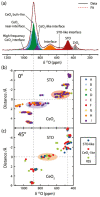Solid State NMR Spectroscopy a Valuable Technique for Structural Insights of Advanced Thin Film Materials: A Review
- PMID: 34200088
- PMCID: PMC8228666
- DOI: 10.3390/nano11061494
Solid State NMR Spectroscopy a Valuable Technique for Structural Insights of Advanced Thin Film Materials: A Review
Abstract
Solid-state NMR has proven to be a versatile technique for studying the chemical structure, 3D structure and dynamics of all sorts of chemical compounds. In nanotechnology and particularly in thin films, the study of chemical modification, molecular packing, end chain motion, distance determination and solvent-matrix interactions is essential for controlling the final product properties and applications. Despite its atomic-level research capabilities and recent technical advancements, solid-state NMR is still lacking behind other spectroscopic techniques in the field of thin films due to the underestimation of NMR capabilities, availability, great variety of nuclei and pulse sequences, lack of sensitivity for quadrupole nuclei and time-consuming experiments. This article will comprehensively and critically review the work done by solid-state NMR on different types of thin films and the most advanced NMR strategies, which are beyond conventional, and the hardware design used to overcome the technical issues in thin-film research.
Keywords: magic angle spinning (MAS); polarization enhancement; sensitivity boosting; solid-state NMR spectroscopy; solvent-matrix interactions; thin films.
Conflict of interest statement
All authors declare no conflict of interest.
Figures








References
-
- Kindlund H., Sangiovanni D.G., Petrov I., Greene J.E., Hultman L. A review of the intrinsic ductility and toughness of hard transition-metal nitride alloy thin films. Thin Solid Film. 2019;688:137479. doi: 10.1016/j.tsf.2019.137479. - DOI
-
- Wang X., Xu P., Han R., Ren J., Li L., Han N., Xing F., Zhu J. A review on the mechanical properties for thin film and block structure characterized by using nanoscratch test. Nano-Technol. Rev. 2019;8:628–644. doi: 10.1515/ntrev-2019-0055. - DOI
-
- Jansson U., Lewin E. Carbon-containing multi-component thin films. Thin Solid Film. 2019;688:137411. doi: 10.1016/j.tsf.2019.137411. - DOI
-
- Zhao C., Li L.-Y., Guo M.-M., Zheng J. Functional polymer thin films designed for anti-fouling materials and biosensors. Chem. Pap. 2012;66:323–339. doi: 10.2478/s11696-012-0147-1. - DOI
-
- Spivack M.A. Mechanical Properties of Very Thin Polymer Films. Rev. Sci. Instrum. 1972;43:985–990. doi: 10.1063/1.1685843. - DOI
Publication types
LinkOut - more resources
Full Text Sources

